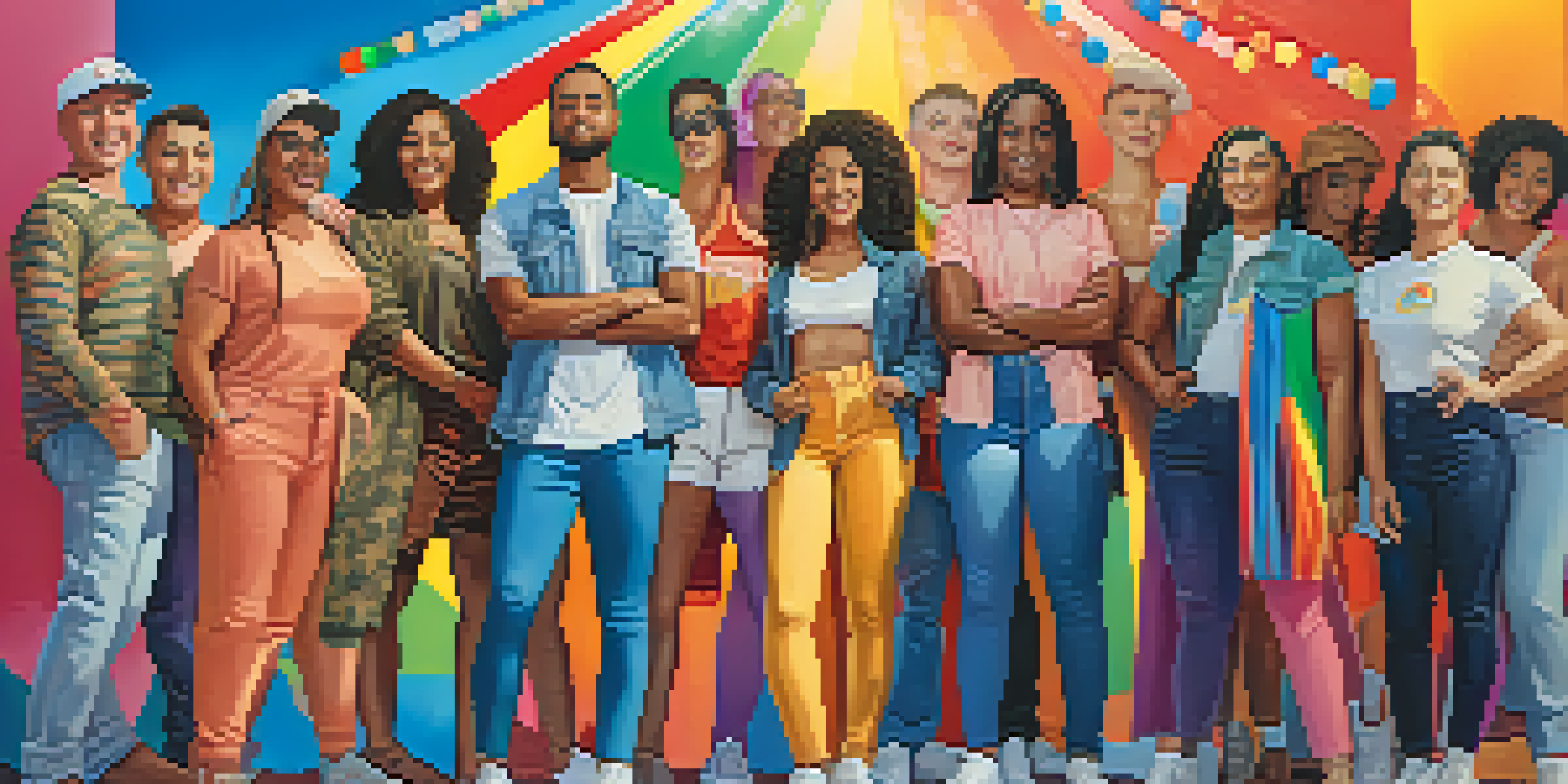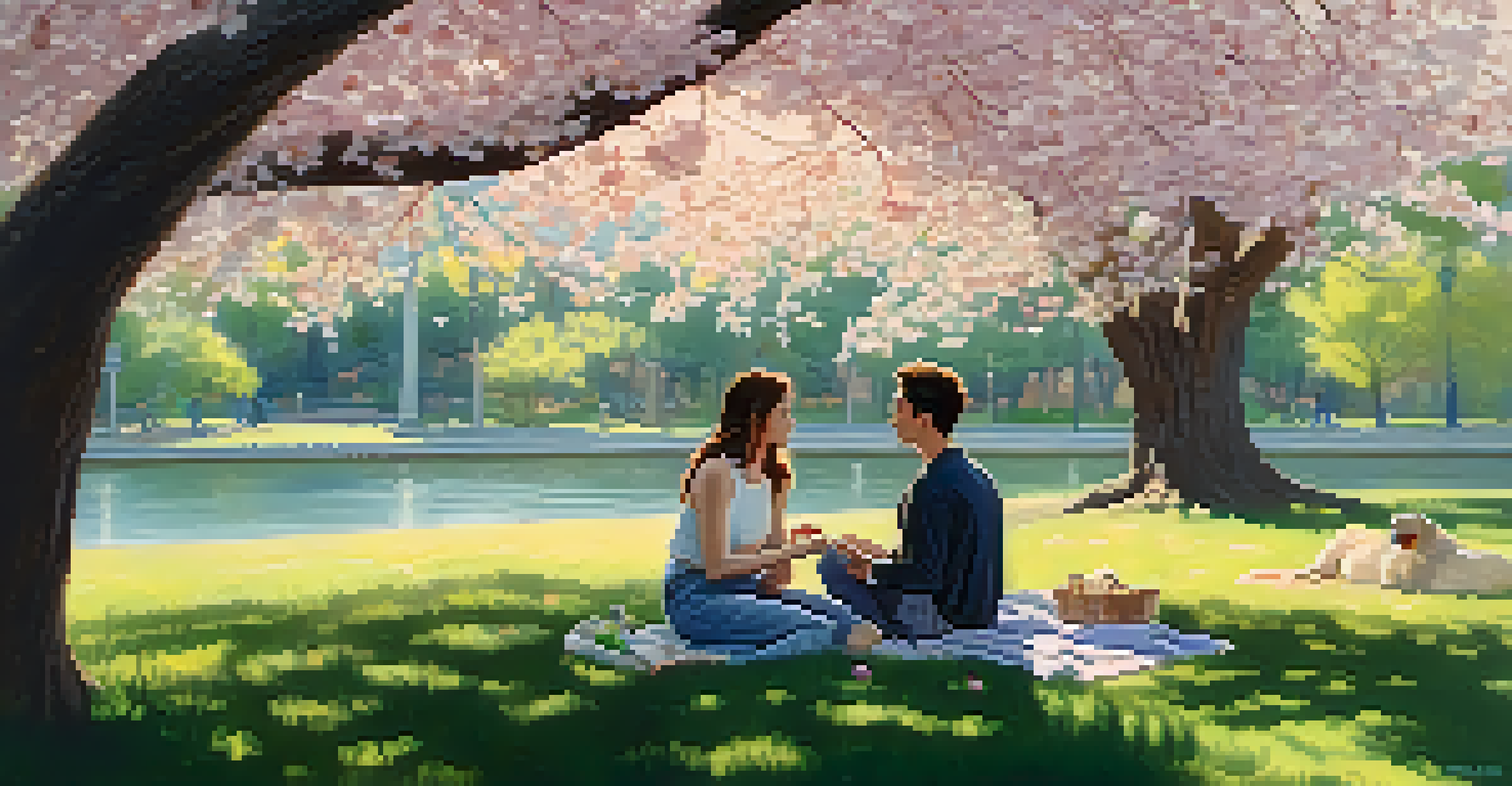Exploring LGBTQ+ Themes in Contemporary Painting Practices

The Evolution of LGBTQ+ Themes in Art
LGBTQ+ themes have a rich history in the art world, evolving significantly over the decades. From the hidden symbols in classical works to the bold statements in modern pieces, artists have always found ways to express their identities. This evolution reflects societal changes and the growing visibility of LGBTQ+ communities, making art a powerful channel for dialogue.
Art is a way of survival. It’s a way to exist, a way to communicate, a way to share experience and tell stories.
In the past, many artists felt compelled to mask their identities due to societal pressures. However, as acceptance has grown, contemporary painters are now able to explore their experiences openly. This shift not only enriches the narrative within their artwork but also invites audiences to engage with these stories on a deeper level.
Today, we see a diverse range of styles and subjects that celebrate LGBTQ+ lives. From abstract representations of identity to poignant portraits that encapsulate personal struggles, contemporary painting serves as a canvas for both joy and pain. This diversity in expression highlights the multifaceted nature of LGBTQ+ experiences in society.
Intersectionality in Contemporary Art
Intersectionality in art refers to how various aspects of identity—such as race, gender, and sexuality—intersect and influence an artist's work. In contemporary painting, this concept is crucial as it allows for a richer understanding of LGBTQ+ narratives. Artists from diverse backgrounds bring unique perspectives that challenge the monolithic view of LGBTQ+ experiences.

For example, a Black queer artist may incorporate cultural elements into their paintings that reflect their lived experiences. This intersectional approach not only broadens the scope of LGBTQ+ art but also amplifies voices that are often marginalized. It encourages viewers to recognize the complexity of identities and their impact on artistic expression.
LGBTQ+ Art Reflects Societal Change
The evolution of LGBTQ+ themes in art mirrors the increasing visibility and acceptance of these communities.
Through vibrant colors, symbolic imagery, and innovative techniques, these artists create works that resonate with a wide audience. By embracing intersectionality, contemporary painters foster a more inclusive discourse within the art world, encouraging empathy and understanding among viewers.
Challenging Norms: Subverting Traditional Aesthetics
Many contemporary LGBTQ+ artists are known for subverting traditional aesthetic norms, creating pieces that challenge conventional beauty standards. By doing so, they invite us to reconsider what we deem 'acceptable' or 'desirable' in art. This act of rebellion not only resonates with their personal narratives but also reflects broader societal critiques.
The role of the artist is to make the revolution irresistible.
For instance, some artists intentionally employ unconventional materials or techniques to disrupt expectations. This can manifest in works that embrace imperfections or highlight raw emotions, fostering a sense of authenticity and vulnerability. Such approaches encourage viewers to engage with the art on a more emotional level.
Ultimately, this challenge to aesthetics serves as a means of empowerment for both artists and audiences. By redefining beauty, these painters create spaces where diverse identities can be celebrated, allowing for a more expansive appreciation of art as a whole.
The Role of Community in Artistic Expression
Community plays a vital role in shaping the artistic expressions of LGBTQ+ individuals. Many contemporary painters draw inspiration from their communities, reflecting shared experiences and collective struggles in their work. This sense of belonging can infuse their art with a unique energy that resonates with viewers who share similar backgrounds.
Collaborative projects, such as community murals or group exhibitions, allow artists to amplify their voices and foster solidarity among LGBTQ+ individuals. These initiatives not only showcase diverse talents but also create safe spaces for dialogue and healing. By sharing their stories, artists contribute to a collective narrative that is both personal and universal.
Intersectionality Enriches Narratives
Artists from diverse backgrounds use intersectionality to challenge monolithic views and amplify marginalized voices.
Furthermore, community engagement can lead to powerful activism through art. Many contemporary LGBTQ+ artists use their platforms to address social issues, advocate for rights, and inspire change. This intersection of art and activism highlights the importance of community in shaping not only the artist's work but also the broader societal landscape.
Exploring Identity through Color and Symbolism
Color and symbolism are powerful tools in contemporary painting, especially for LGBTQ+ artists exploring their identities. Each color can evoke specific emotions and meanings, allowing artists to convey complex narratives without words. For instance, the use of rainbow hues often signifies pride and unity within the LGBTQ+ community.
Symbolism in art can also communicate deeper layers of meaning. Artists may incorporate motifs like butterflies to represent transformation or chains to signify oppression. These symbols create an additional layer of connection between the artist and the viewer, inviting them to delve into the stories behind the artwork.
By skillfully blending color and symbolism, contemporary painters create immersive experiences that resonate with their audience. This approach not only enhances the visual appeal of their work but also deepens the emotional impact, fostering conversations around identity and belonging.
Narratives of Resilience and Empowerment
Contemporary LGBTQ+ painting often tells stories of resilience and empowerment, reflecting the journey of individuals who have faced adversity. Many artists draw from their personal experiences of struggle, using their work to portray themes of triumph over challenges. This narrative of resilience serves as both a healing process for the artist and a source of inspiration for viewers.
For example, a painting depicting a figure emerging from darkness into light can symbolize hope and recovery. By visualizing these transformative moments, artists create a dialogue around mental health, acceptance, and personal growth. Such narratives resonate deeply with those who have faced similar challenges, fostering a sense of connection.
Digital Media Expands Art Access
Digital platforms provide LGBTQ+ artists with new avenues for expression and connection, enhancing their reach and impact.
Moreover, these stories of empowerment encourage a broader conversation about LGBTQ+ rights and representation. By sharing their journeys, artists not only validate their experiences but also inspire others to embrace their identities proudly, contributing to a culture of acceptance and understanding.
The Impact of Digital Media on LGBTQ+ Art
Digital media has revolutionized the way contemporary LGBTQ+ artists share their work, providing new platforms for visibility and engagement. Social media, in particular, allows artists to connect with a global audience, breaking down geographical barriers. This accessibility fosters a vibrant online community where artists can share their stories and connect with supporters.
Furthermore, digital tools enable innovative artistic expressions that challenge traditional painting methods. Artists can experiment with digital painting, animation, and mixed media, expanding the boundaries of their creativity. This experimentation not only enhances their artistic repertoire but also invites viewers to engage with art in dynamic new ways.

As a result, digital media has become a powerful ally for LGBTQ+ artists, amplifying their voices and enabling them to reach wider audiences. This shift has transformed the landscape of contemporary art, making it more inclusive and reflective of the diverse experiences found within the LGBTQ+ community.
Looking Forward: The Future of LGBTQ+ Art
As we look to the future, the landscape of LGBTQ+ art continues to evolve, promising exciting possibilities for new expressions and narratives. Emerging artists are exploring innovative techniques and themes, pushing the boundaries of what contemporary painting can represent. This ongoing evolution ensures that LGBTQ+ stories remain relevant and resonant in the art world.
Additionally, the increasing support for LGBTQ+ artists and their work is creating more opportunities for representation in galleries, museums, and public spaces. This shift is vital for fostering a more inclusive art community that celebrates diversity. By prioritizing LGBTQ+ voices, the art world can better reflect the richness of human experience.
Ultimately, the future of LGBTQ+ art is bright, filled with potential for change, dialogue, and connection. As more artists continue to share their unique perspectives, we can expect a vibrant tapestry of creativity that inspires and empowers both the art community and society at large.